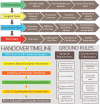Standardization of Postoperative Transitions of Care to the Pediatric Intensive Care Unit Enhances Efficiency and Handover Comprehensiveness
- PMID: 30229145
- PMCID: PMC6132582
- DOI: 10.1097/pq9.0000000000000004
Standardization of Postoperative Transitions of Care to the Pediatric Intensive Care Unit Enhances Efficiency and Handover Comprehensiveness
Abstract
Introduction: To determine the impact of standardization of postoperative transitions of care to the pediatric intensive care unit on handover efficiency and the quality of healthcare data exchange.
Methods: This was a prospective, pre-post observational study after standardization of postoperative transitions in a 44-bed pediatric intensive care unit in a 313-bed tertiary care pediatric hospital from April to July 2015. Standardization was completed using a multidisciplinary handover checklist. Primary outcomes were efficiency expressed as mean handover duration and the comprehensiveness of healthcare data exchange.
Results: Forty-seven postoperative transitions were observed of which 23 were preintervention and 24 were postintervention. After standardization, efficiency improved from 10.5 ± 5.4 to 7.8 ± 2.7 minutes (P < 0.05). Healthcare data exchanged between surgical, anesthesia, and critical care providers were more robust including intraoperative, historical, and anticipatory guidance (all P < 0.05). After intervention, attendance through completion of handover for surgical services increased from 13% to 88% (P < 0.05).
Conclusions: Standardization of postoperative transitions improved efficiency, healthcare data exchange, and anticipatory planning. Future research is required to link standardization of transitions to improved patient outcomes and measure the development of shared mental models.
Figures
References
-
- Bigham MT, Logsdon LR, Manicone PE, et al. Decreasing handoff-related care failures in children’s hospitals. Pediatrics. 2014;134:e572–e579. - PubMed
-
- Pucher PH, Johnston MJ, Aggarway R, et al. Effectiveness of interventions to improve patient handover in surgery: a systematic review. Surgery. 2015;158:85–95. - PubMed
-
- Nagpal K, Abboudi M, Manchanda C, et al. Improving postoperative handover: a prospective observational study. Am K Surg. 2013;206:494–501. - PubMed
LinkOut - more resources
Full Text Sources
Other Literature Sources
Miscellaneous

